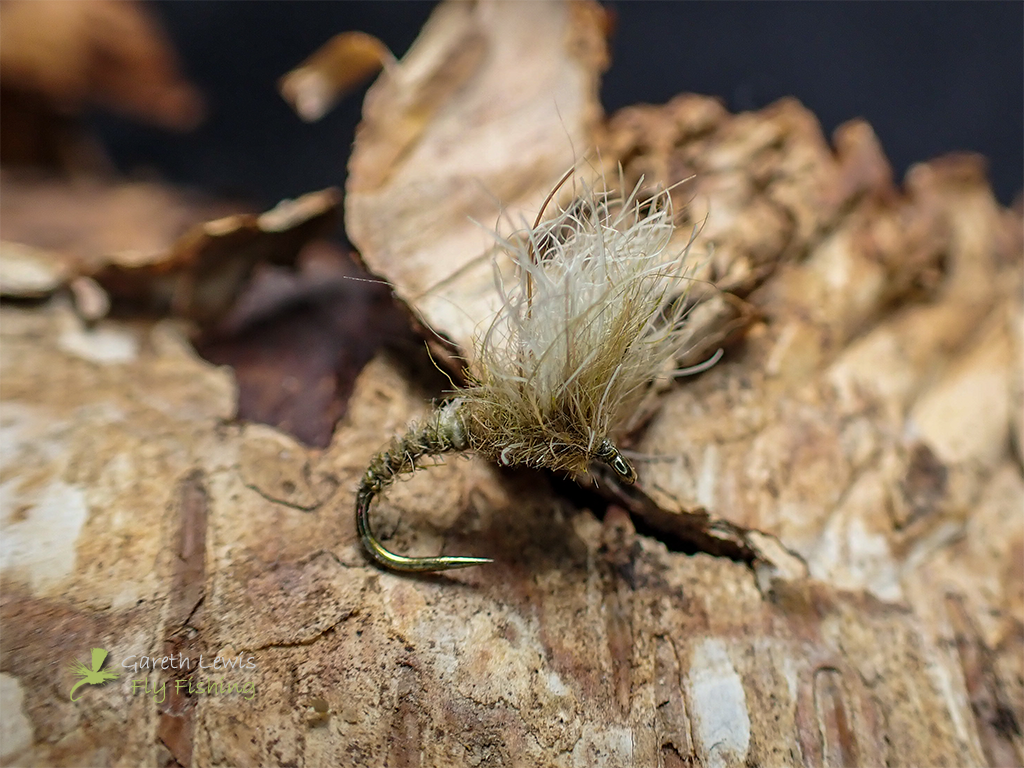Initially developed by Bob Wyatt as a follow-up to his Deer Hair Emerger (DHE), the Snowshoe Hare Emerger (SHE) is a fantastic pattern that imitates a vast range of invertebrates and caddis and, at a push, I don’t see why it wouldn’t feel comfortable imitating midge. Its messy, noisy, buggy footprint is perfect for the ‘less sexy’ emerging stage of the Ephemeroptera as, unlike its older dun and spinner cousins, the emerger is an outright mess while acting as a perfect target for feeding trout. This is a discernible and highly buoyant pattern thanks to the Snowshoe wing.
When tying this pattern, chats with Bob have indicated he favours tying in the wing a little further back, certainly when compared to some of the CdC-focussed shuttlecock patterns. This pattern must sit in the film, as opposed to sitting verticle through the film.
I also ensure that the abdomen is dubbed and then trimmed tightly. I always tie the abdomen with Hare’s Mask and trim with my scissors, but others opt to use dubbings that sit tighter straight away. Superfine dubbing, for example, is great for this. Importantly, what we’re trying to achieve is a tight abdomen so that it pierces the surface film in order to position the pattern to sit as an emerging invertebrate. I use the same Hare’s Mask dubbing for the thorax, but this is dubbed via a split thread so that it’s more spiky and indicative of legs (as well as the other ‘bits’ that burst free as per any respective and generally messy emerger will tell you).
Materials
- Hook: Tiemco TMC2487, size 14
- Thread: Semperfli Nano Silk (12/0 / 50D), white
- Abdomen: Hare’s fur, tied behind the wing and wound down to the curve
- Rib: Thread, after the abdomen dubbing is applied, wind back up in open turns to behind the eye
- Wing: Snowshoe Rabbit Foot, cream
- Thorax: Hare’s Mask, via split thread (or dubbing noodle and picked-out)
Fishing-wise, I use this on all my waters. From the small freestone streams that thread their way through our Welsh mountains and valleys to the larger main stems of the Usk. It fishes well on fast broken water and even on glassy glides of longer pools, and it’s visible as hell throughout. I grease the wing very lightly before fishing, and when it eventually succumbs to waterlogging, I dry it off using desiccant powder.
Hint, don’t over-dub the abdomen, as this (in conjunction with your choice/wire gauge of hook) could sink the pattern. If this is the case, try switching the hare’s fur abdomen for a synthetic, Superfine-style dubbing, which may solve your issue.


Further Reading
Bob Wyatt is a man who needs no introduction. His books have been invaluable to my own fishing life, as have his observations on trout via magazine articles and podcasts. The below are absolute must-reads/listens.
- Trout Hunting: The Pursuit of Happiness, 2004, Bob Wyatt
- What Trout Want: The Educated Trout and Other Myths, 2013, Bob Wyatt




Thanks Gareth,
Very interesting instructions on construction of fly, especially about the thorax.
However, I still suspect this pattern would catch fish if slightly sunk.
Will have to tie some and try on southern lakes.
Thanks John! And you’re bang on, it absolutely will catch when slightly sunk. From memory, Bob’s original instruction actually focussed on just that. Have fun and let me know how they do on the southern lakes.